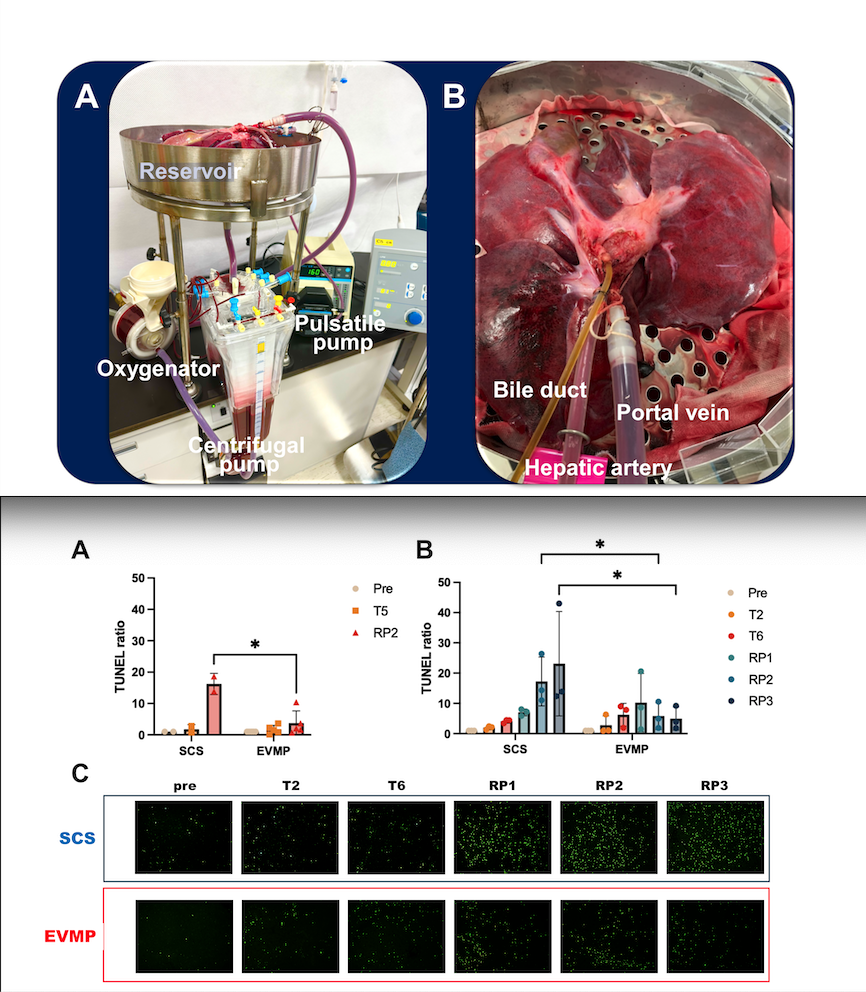Development and optimization of transplant surgeon-innovated EVMP: Validation in a porcine DCD liver transplant model
Mun Chae Choi1, Yuri Cho2, Sat Byol Lee2, Eun-Ki Min2,3, Deok-Gie Kim2,3, Jae Geun Lee2,3, Myoung Soo Kim2,3, Soo Han Bae4, Dong Jin Joo2,3.
1Surgery, Armed Forces Capital Hospital, , Seongnam, Korea; 2The Research Institute for Transplantation, Yonsei University College of Medicine, Seoul, Korea; 3Surgery, Yonsei University College of Medicine, Seoul, Korea; 4Biomedical Sciences, Yonsei University College of Medicine, Seoul, Korea
Background: Ex vivo machine perfusion (EVMP) is increasingly recognized as a promising technique for enhancing the preservation and viability of donor organs, particularly in donation after circulatory death (DCD) liver transplantation (LT). However, in the Republic of Korea, the lack of established large animal models for DCD LT and the absence of commercially available EVMP devices have limited the progress of such studies. This gap highlights the need for further development in experimental infrastructure to facilitate cutting-edge research in EVMP and its applications within Korea’s unique clinical and regulatory environment.This study validates a transplant surgeon-innovated EVMP protocol by assessing its efficacy in a porcine DCD-simulated liver transplant model.
Methods: 26 Yorkshire pigs were used to compare static cold storage (SCS) and EVMP. In Model 1, the SCS group (n=5) underwent 5 hours of SCS, while the EVMP group (n=9) had 1 hour of SCS followed by 4 hours of EVMP. In Model 2, with adjusted lower target portal flow and hepatic artery pressure, the SCS group (n=6) underwent 6 hours of SCS, while the EVMP group (n=6) had 2 hours of SCS followed by 4 hours of EVMP. Hemodynamic stability during perfusion, laboratory findings, and apoptosis (via TUNEL assay) after reperfusion were evaluated.
Results: The EVMP system successfully performed all 15 cases without technical complications. Hemodynamic parameters were stably maintained during perfusion. In model 1, there were no significant differences in laboratory findings between two groups. In Model 2, AST, ALT, INR and LDH levels were significantly lower in the EVMP group after reperfusion. In model 1, the SCS group showed significantly higher TUNEL-positive cell ratios than the EVMP group at 2 hours after reperfusion (16.2 ± 3.4 vs. 3.7 ± 3.9, P < 0.001). In model 2, starting from 2 hours after reperfusion, the EVMP group demonstrated a markedly lower TUNEL ratio compared to the SCS group (5.8 ± 4.4 vs. 17.2 ± 8.1, P = 0.043 at RP2; 5.0 ± 3.8 vs. 23.1 ± 17.3, P = 0.002 at RP3).
Conclusions: This study successfully demonstrated the stability of the transplant surgeon-innovated EVMP protocol, validating its efficacy in improving organ preservation and reducing ischemic-reperfusion injury in a porcine DCD sLT model.

[1] Perfusion
[2] warm ischemia
[3] liver transplantation
[4] reperfusion injury
[5] experimental animal models.